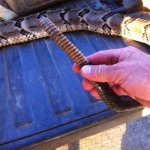july1952
Member
This is the biggest (size wise) rattlesnake I've ever seen. However, it's an allusion in size.
It’s one of the oldest photography tricks in the book — take a camera with a wide-angle or short lens, stand back from the subject (which is very close to the camera), and snap a photo. It’s a trick used by bear hunters and deer hunters on a regular basis . . . and people with dead snakes on the end of a stick. (Side note: A few years ago, a poor photocopy of a dead snake on a stick in similar manner circulated in Scott County. It was supposedly a snake killed by local utility workers who were working under a house in a remote part of the county. Needless to say, it was easily proven false.)
This is a nice-sized rattlesnake, but obviously it isn’t as big as the photo would suggest. If it were, it would be at least 10 ft. long (assuming the man is an average 6 ft. tall). It is an eastern diamondback, which averages 5.5 ft. in length. The very largest of the species are seldom larger than 7 ft. in length, and there is certainly no documented evidence of an eastern diamondback nearly 10 ft. in length.
These next two pictures are the real deal. My nephew and his son killed this gigantic rattler, with a baseball bat! Five feet two inches long and 20 rattles.
It’s one of the oldest photography tricks in the book — take a camera with a wide-angle or short lens, stand back from the subject (which is very close to the camera), and snap a photo. It’s a trick used by bear hunters and deer hunters on a regular basis . . . and people with dead snakes on the end of a stick. (Side note: A few years ago, a poor photocopy of a dead snake on a stick in similar manner circulated in Scott County. It was supposedly a snake killed by local utility workers who were working under a house in a remote part of the county. Needless to say, it was easily proven false.)
This is a nice-sized rattlesnake, but obviously it isn’t as big as the photo would suggest. If it were, it would be at least 10 ft. long (assuming the man is an average 6 ft. tall). It is an eastern diamondback, which averages 5.5 ft. in length. The very largest of the species are seldom larger than 7 ft. in length, and there is certainly no documented evidence of an eastern diamondback nearly 10 ft. in length.
These next two pictures are the real deal. My nephew and his son killed this gigantic rattler, with a baseball bat! Five feet two inches long and 20 rattles.
Attachments
Last edited:





